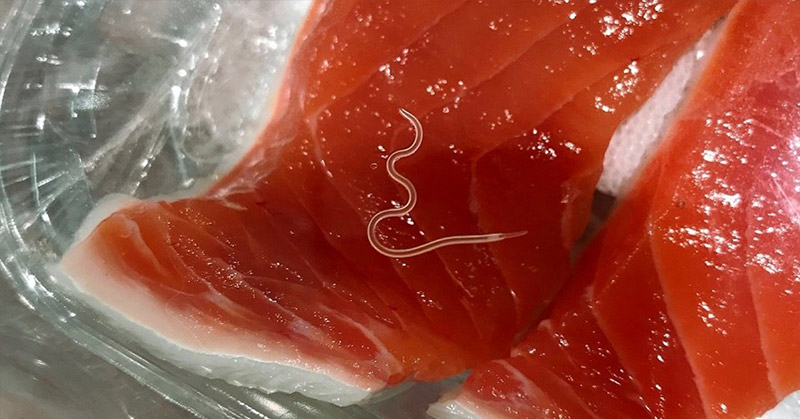Sushi lovers, be aware! While sushi is often a delicious and fun dining experience, recent studies suggest that parasitic worm populations are skyrocketing in certain fish species used in sushi. The rapid increase of these parasites in sushi fish raises questions about safety and the risks of eating raw seafood. This article dives into why parasitic worms are rising, how they impact both marine life and humans, and whether you should reconsider that next sushi dinner.
What Are Parasitic Worms Found in Sushi?

Parasitic worms, specifically Anisakis, are nematodes commonly known as whale worms. They inhabit various marine species, including fish and marine mammals like whales and seals. These worms have been infecting fish at an alarming rate, increasing by 283 times since the 1970s, according to research published in Global Change Biology. These worms can grow up to two centimeters long and cause health issues like vomiting, diarrhea, and more serious complications when consumed by humans.
The Growing Threat of Anisakis: Understanding the Numbers
Recent studies reveal an alarming trend: in the 1970s, researchers found fewer than one worm per 100 fish. Today, it’s not uncommon to discover multiple worms per individual fish. This surge in worm populations is unsettling, especially considering that over 55,000 worms have been found in 215 fish species globally since 1967. Some fish remain parasite-free, while others are heavily infected, indicating a significant increase in the risk of contamination in sushi fish.
How Parasitic Worms Infect Fish and Humans
Ever wondered how these worms make their way into your sushi? Here’s how the process works:
- Whales and Marine Mammals as Hosts: The life cycle of Anisakis starts with marine mammals like whales, dolphins, and seals, which host the adult worms. The parasites release their eggs through the mammals’ feces into the ocean.
- Larval Stage in the Ocean: The eggs hatch into larvae in the water, which are then consumed by crustaceans and mollusks. Krill, in particular, play a crucial role as intermediate hosts since they are a primary food source for fish and squid.
- Fish as Intermediate Hosts: The larvae attach to the intestines or internal organs of fish and squid. These infected fish then become part of the food chain, eventually consumed by humans or marine mammals.
- Human Infection Through Sushi: Humans become accidental hosts by eating raw or undercooked fish or squid contaminated with Anisakis. This can lead to a condition known as anisakiasis, characterized by symptoms like abdominal pain, nausea, and a tingling sensation in the throat.
What Are the Health Risks of Eating Parasitic Worms?
Eating sushi comes with some risk, as consuming Anisakis can lead to anisakiasis. This infection causes various symptoms, including:
- Tingling Sensation: Some people feel a tingling or tickling sensation in their mouth or throat while eating raw fish. This could be a live worm attempting to move.
- Abdominal Pain and Nausea: The parasite can cause pain in the stomach and nausea as it moves through the digestive tract.
- Allergic Reactions: In some cases, consuming the parasite can trigger allergic reactions, ranging from mild itching to severe anaphylaxis.
It’s worth noting that anisakiasis is not contagious and cannot spread from person to person.
Why Are Parasitic Worms Increasing in Fish?
The rapid increase in parasitic worms found in fish used in sushi raises questions about what’s driving this trend. Here are the main factors contributing to this surge:
- Rebounding Whale Populations: As some whale populations recover due to successful conservation efforts, they provide more hosts for Anisakis, leading to higher levels of parasitic eggs released into the ocean.
- Climate Change Impacts: Warming ocean temperatures may accelerate the parasite’s life cycle, making it easier for them to multiply and spread. Although this theory is still under study, the correlation between warmer waters and increased parasitic presence cannot be ruled out.
- Overfishing and Disrupted Ecosystems: Overfishing may alter marine ecosystems, allowing parasitic populations to thrive by reducing the number of natural predators. This creates an imbalance, making it easier for parasites to spread to fish species commonly consumed by humans.
Is It Safe to Eat Sushi Despite the Risk?

Despite the increased presence of parasitic worms in sushi fish, it’s not all bad news. Freezing or cooking fish effectively kills Anisakis, making cooked seafood a safer option. While raw sushi and sashimi do pose a higher risk, sushi chefs are trained to inspect fish meticulously and remove visible worms before serving.
Even Dr. Chelsea Wood, a parasite ecologist at the University of Washington, continues to enjoy sushi despite spending her days studying these worms. According to her, experienced sushi chefs are often better than scientists at spotting and removing the worms. Still, it’s wise to inspect your food before eating and choose reputable sushi restaurants to reduce the risk.
What Does This Mean for Marine Life?
The spike in Anisakis populations isn’t just a human concern; it’s also a potential problem for marine life. For marine mammals, carrying these worms could affect their health, although the full impact is still unclear. For fish, the infection can lead to more obvious problems. For example, infected Atlantic salmon often develop red vent syndrome, a condition characterized by swelling and bleeding in their digestive tracts.
Conclusion
The rise in parasitic worms in fish used for sushi is a concerning trend that deserves attention. While the thought of worms in sushi might be unsettling, it’s not necessarily a reason to swear off your favorite rolls entirely. The risk can be minimized by selecting reputable sushi restaurants, inspecting your food, and choosing cooked or frozen fish options. Awareness is key, so stay informed and make educated decisions about your seafood consumption. The next time you sit down to enjoy a sushi roll, you’ll know what to look for!


